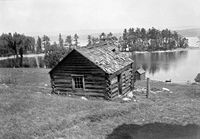
Horaceville, Ontario
Encyclopedia

Ottawa River
The Ottawa River is a river in the Canadian provinces of Ontario and Quebec. For most of its length, it now defines the border between these two provinces.-Geography:...
in eastern Ontario
Ontario
Ontario is a province of Canada, located in east-central Canada. It is Canada's most populous province and second largest in total area. It is home to the nation's most populous city, Toronto, and the nation's capital, Ottawa....
, Canada, owned and operated by the City of Ottawa
Ottawa
Ottawa is the capital of Canada, the second largest city in the Province of Ontario, and the fourth largest city in the country. The city is located on the south bank of the Ottawa River in the eastern portion of Southern Ontario...
. This location is also known as Pinhey's Point Historic Site. The site consists of 88 acres (356,123.7 m²) of park land, a stone manor house, two barns, and several stone ruins. The manor house acts as a historic house museum with furnished rooms and temporary exhibits. The City of Ottawa offers multiple programs for families throughout its operating season (May - August) as well as some programs in the off-season. The park itself is open year-round. Admission to the museum is by donation; some of the programs and special events charge a small fee for participation.
History
Hamnett Kirkes PinheyHamnett Kirkes Pinhey
Hamnett Kirkes Pinhey was a Canadian landowner and politician.-Early years:...
, an English
England
England is a country that is part of the United Kingdom. It shares land borders with Scotland to the north and Wales to the west; the Irish Sea is to the north west, the Celtic Sea to the south west, with the North Sea to the east and the English Channel to the south separating it from continental...
merchant, petitioned Lord Bathurst
Henry Bathurst, 3rd Earl Bathurst
Henry Bathurst, 3rd Earl Bathurst KG PC was a British politician.-Background and education:Lord Bathurst was the elder son of Henry Bathurst, 2nd Earl Bathurst, by his wife Tryphena, daughter of Thomas Scawen...
, Colonial Secretary at the time, for land in Canada
Canada
Canada is a North American country consisting of ten provinces and three territories. Located in the northern part of the continent, it extends from the Atlantic Ocean in the east to the Pacific Ocean in the west, and northward into the Arctic Ocean...
as reward for his service in the British Army
British Army
The British Army is the land warfare branch of Her Majesty's Armed Forces in the United Kingdom. It came into being with the unification of the Kingdom of England and Scotland into the Kingdom of Great Britain in 1707. The new British Army incorporated Regiments that had already existed in England...
and received a 1000 acre (4 km²) land grant. He retired from business, left England and travelled to Upper Canada
Upper Canada
The Province of Upper Canada was a political division in British Canada established in 1791 by the British Empire to govern the central third of the lands in British North America and to accommodate Loyalist refugees from the United States of America after the American Revolution...
around 1820. On his lands in March Township
March Township, Ontario
March Township is a geographic township and former municipality originally part of Carleton County in eastern Ontario, Canada. It is currently part of the City of Ottawa...
, he built a grist mill, homes for employees and a small two storey log house covered in clapboard
Clapboard (architecture)
Clapboard, also known as bevel siding or lap siding or weather-board , is a board used typically for exterior horizontal siding that has one edge thicker than the other and where the board above laps over the one below...
. There were seven small cannons facing the river. Pinhey, who continued to prosper as a politician and insurance broker, named the estate, Horaceville, after his oldest son Horace. Horace was to be the heir to the estate, in accordance with British aristocratic tradition.
Buildings
A stone parlour and three small upstairs bedrooms for the servants were added to the home between 1822 and 1825. In 1841, Pinhey added a central hall kitchen wing with a sweeping staircase leading upstairs to a dining room and a bedroom over the front entrance. In 1848 and 1849, a south wing was added with a library, pantry, drawing room and more bedrooms on the second floor.Other buildings on the site included a barn, stone stable, powder magazine and St. Mary's Church. The construction of the church began on 1825 and the first service was held on October 7, 1827. The opening featured a seven gun salute from the cannons. The building of the church on this site was opposed by the bishop of Quebec, who felt that the church should be built further inland. Even though Pinhey donated part of his land and the labour costs, the bishop still refused to consecrate the church.
The site remained the property of Pinhey's heirs until the 1970s, when the property was sold to the township. Today, The 88 acres (356,123.7 m²) heritage site is owned and operated by the City of Ottawa and Pinhey's home serves as a museum.

